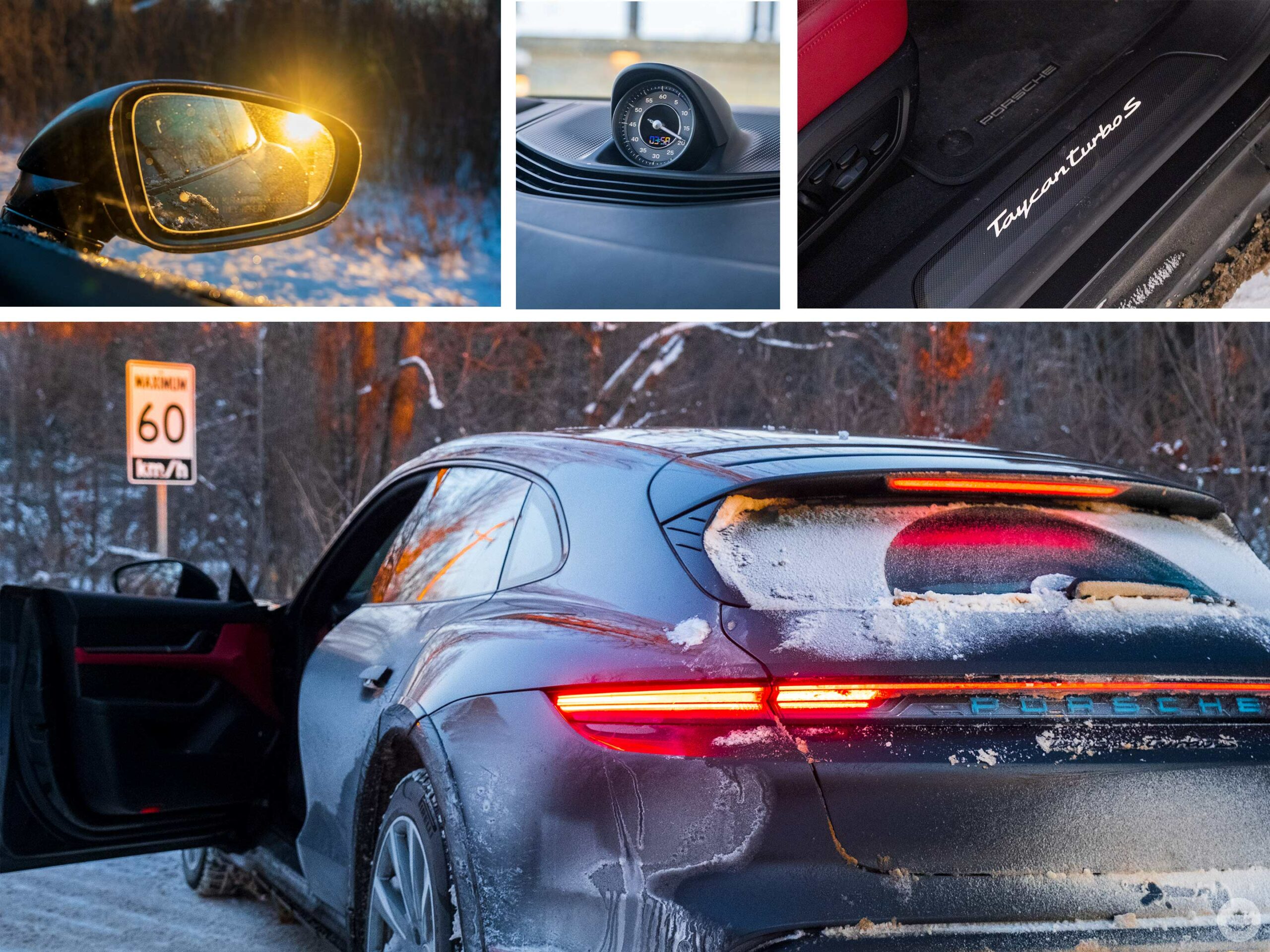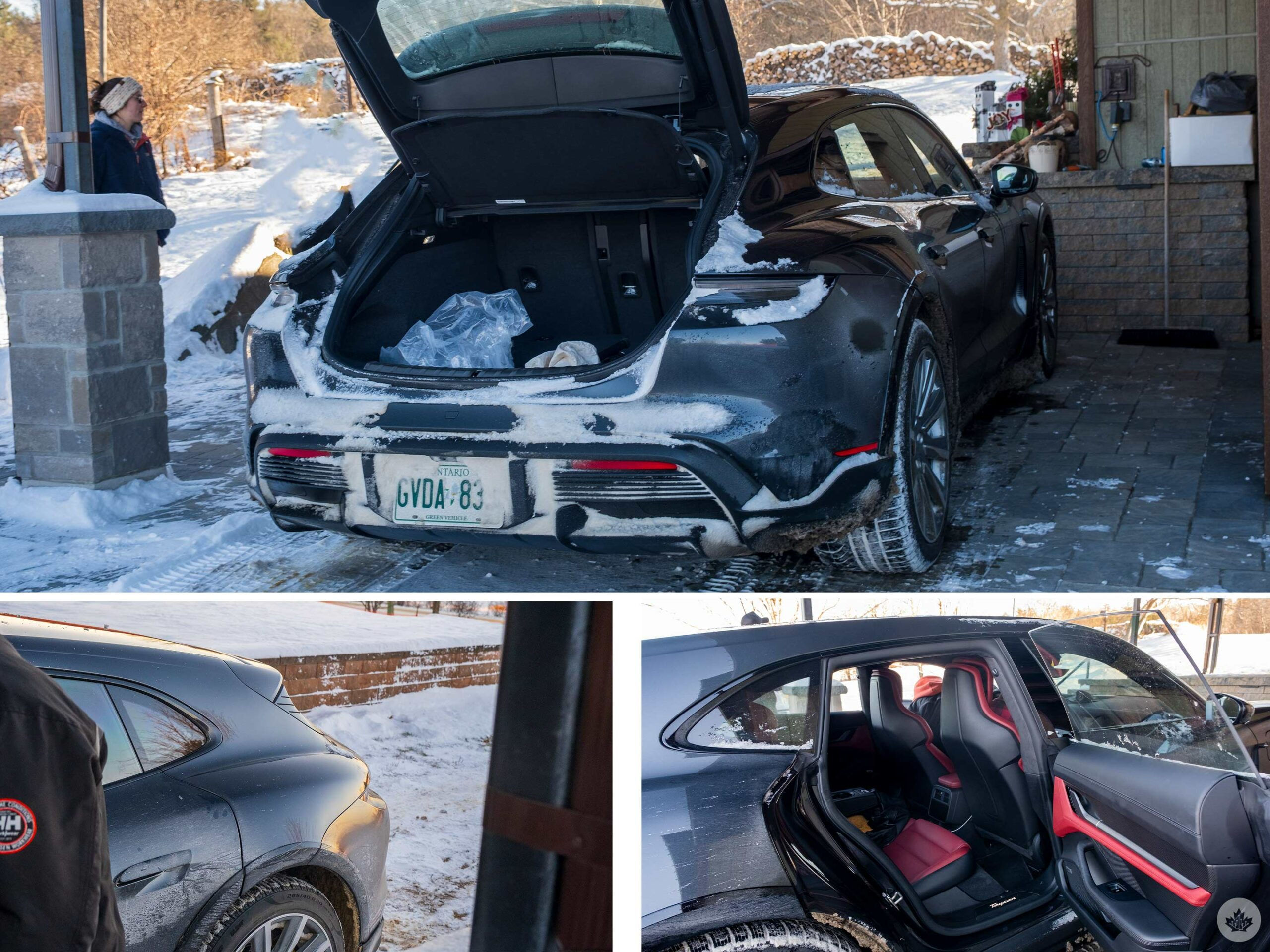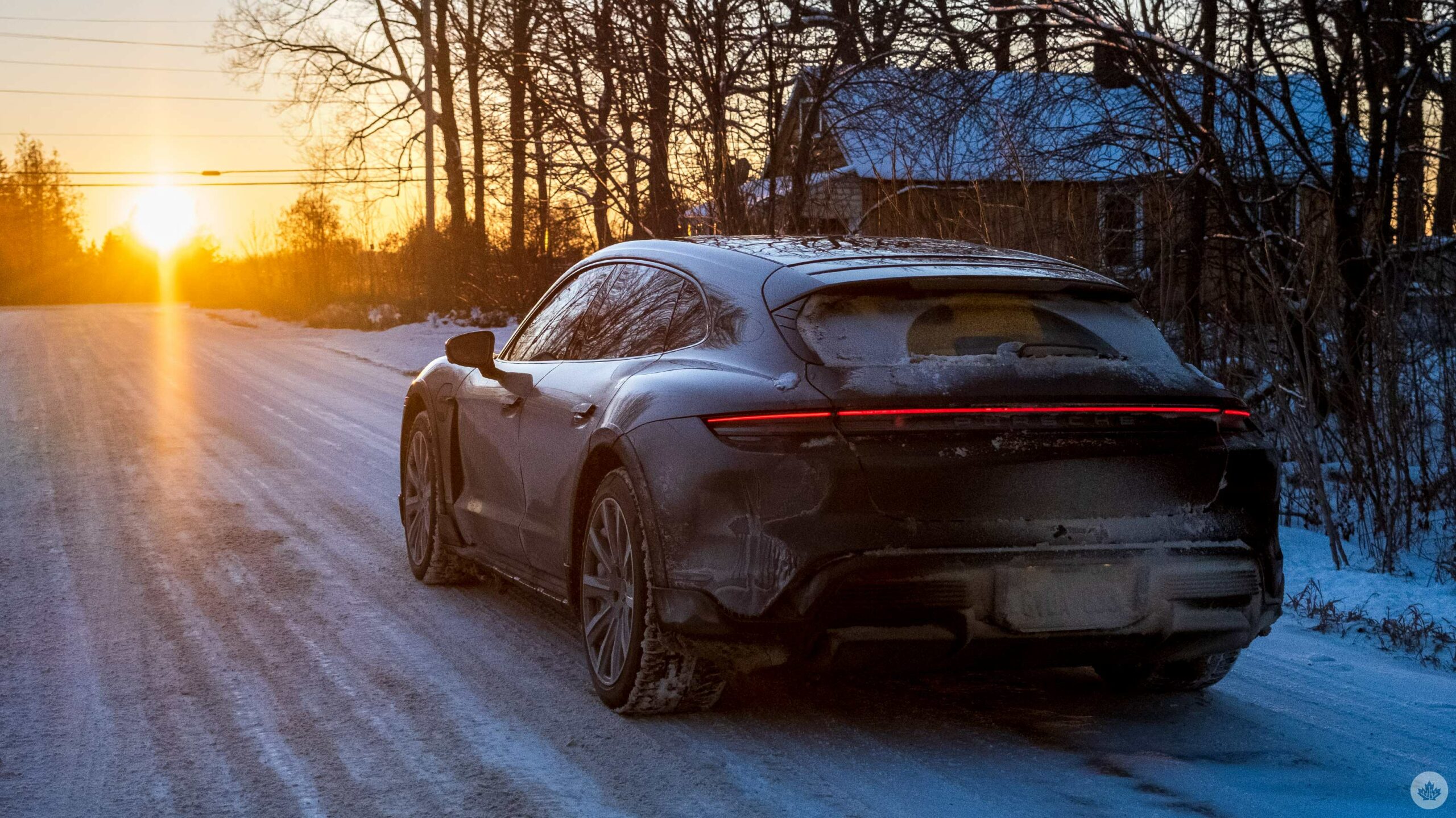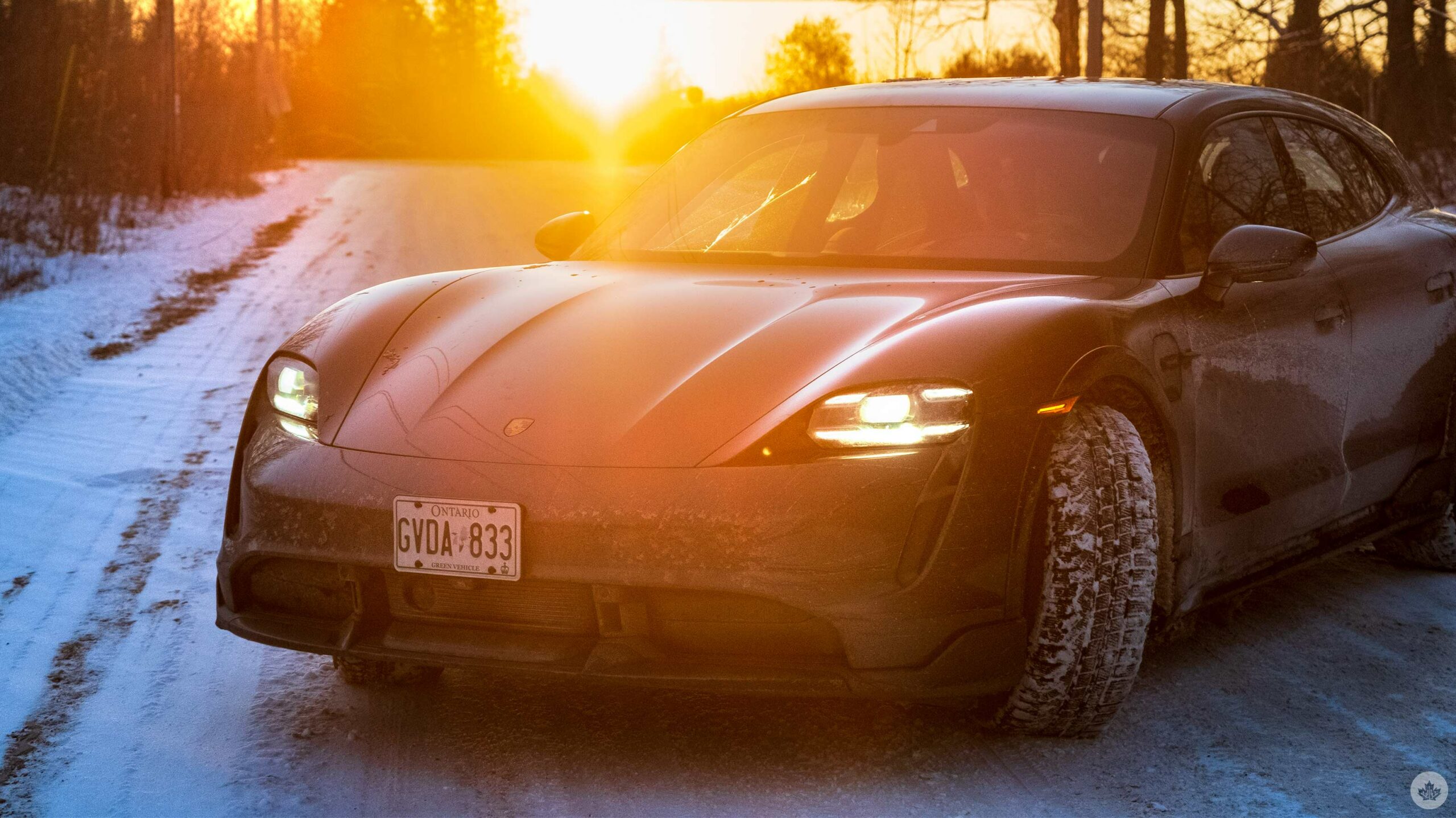
The Pros
- Faasssstttt
- Gravel mode is nice on snow
- Has fast charging architecture
The Cons
- Kicks up slush/snow all over the rear window
- Digital climate controls are annoying
- No regular defrost button, only MAX defrost
I didn’t think I’d be writing this, but I don’t know if I like the regular Porsche Taycan or the Cross Turismo more.
Both electrified Porsche vehicles share a ton of DNA, so they drive fantastically under optimal conditions. With this in mind, it comes down to comparing the regular Taycan’s aggressive and sporty shape to the Cross Turismo’s slightly more bulbous body and its enhanced ability to drive on gravel roads, and, notably in Canada, snow.
Over the past four days, I’ve taken the Taycan all over rural Ontario, drove through a pretty significant snowfall, on lots of gravel roads, and charged the EV a lot. If you’re wondering what it’s like to drive the Taycan Cross Turismo during a cold Canadian winter, I’ve got you covered.
A car begging to be driven
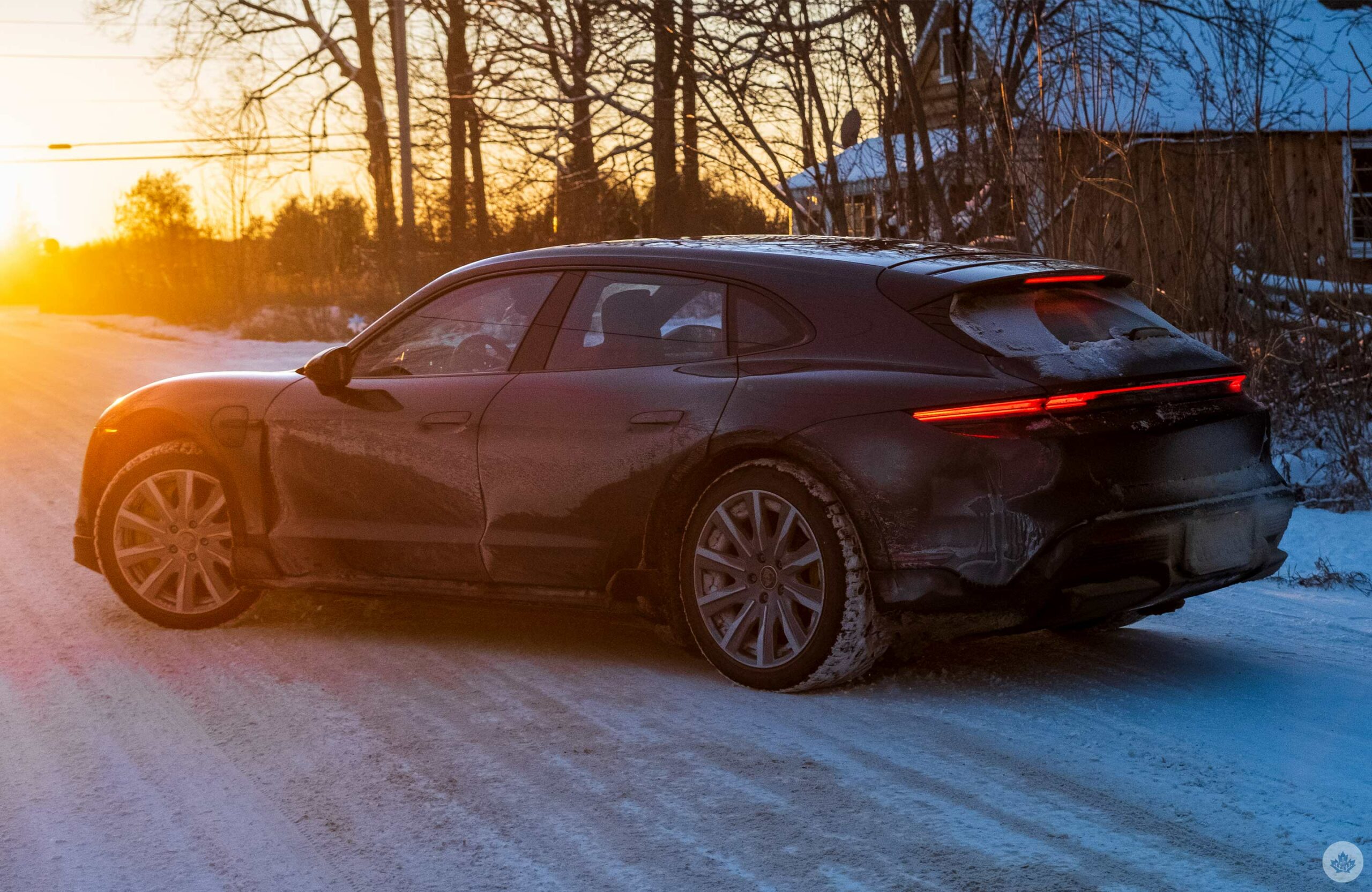
I was lucky enough to drive a fully loaded Turbo S variant with all of the bells and whistles. This means the car packs 750-horsepower, an average 380km of range, and a 0-100 speed that just squeaks under the three-second mark. Overall, the Taycan Cross Turismo is an imposing car, both on the spec sheet and behind the wheel.
The day-to-day driving experience on dry roads was very similar to my experience with the standard Taycan. It’s swift off the line, the breaks are phenomenal, and the steering feels incredibly responsive. I haven’t driven many cars this expensive, but to me, the Taycans feel several steps above an everyday consumer vehicle. They’re thrilling while still providing the driver with an exceptional amount of control that makes you feel like the ruler of the road.

With this much power, there are bound to be some slips on snow if you push it, but the grip on the road, whether it be from the weighty batteries holding the car’s centre of gravity or its all-wheel-drive setup, is impressive and keeps the Cross Turismo pushing forward relentlessly as long as you keep your foot on the pedal.
Speaking of snow, around 3cm of relatively dry snow was on the roads on the Saturday of my Friday-to-Monday loan period with the car. It got pretty slushy and wasn’t great to drive on, but the Taycan Cross Turismo handled the dry, loose snow admirably.
When it came to the heavier, wet slush, things were a bit more slippery, but I never felt overly concerned. That said, it does kick up a lot of slush and snow all over the back of the car, covering your plate and rear window.
The window has a tiny wiper, but it’s not the greatest, and the rear defrost didn’t appear to be working in my unit, so that was a bit of a pain when taking it out in the winter. That said, if you own this $100,000+ car, you likely have a second more capable vehicle to tackle the intense Canadian weather. Since EVs generally fare better near urban hubs with lots of chargers, I don’t expect most Cross Turismo owners to be driving on snowy rural roads as much as I did this weekend.
“Sitting in the front seats of the Taycan Cross Turismo feels just as sporty and elegant as the regular Taycan.”
There is also a gravel mode that limits your acceleration a bit and raises the car to its max height. I found this to be handy in the winter since the limited acceleration helped me grab traction in the snow. Compared to the ultra-low Taycan, the added height here was incredibly reassuring.
What you gonna do with all that junk inside that trunk?
Sitting in the front seats of the Taycan Cross Turismo feels just as sporty and elegant as the regular Taycan. However, there’s an extra 5cm of headroom in the rear for passengers, but it still slopes in at the edges rather aggressively. This means that most people will still hit their heads on the sides inside. Still, it’s not as bad as the Taycan and sitting in the middle seat, I found there to be enough headroom for me (I’m 6ft).
This enlarged rear also means there is a bit more trunk space. I took it home to visit my parents on the weekend with my clothes, my girlfriend Alex’s clothes, all of our lights and camera gear, and even more stuff, and it all fit in the back and the front trunks. I think if you packed smartly enough, a family of four could store a few suitcases and backpacks into this thing easily.
It’s not as spaciously designed as the Hyundai Ioniq 5, but if you want an electric Porsche or a high-performance EV with some extra space, this is the mark.
Infotainment and Innodrive
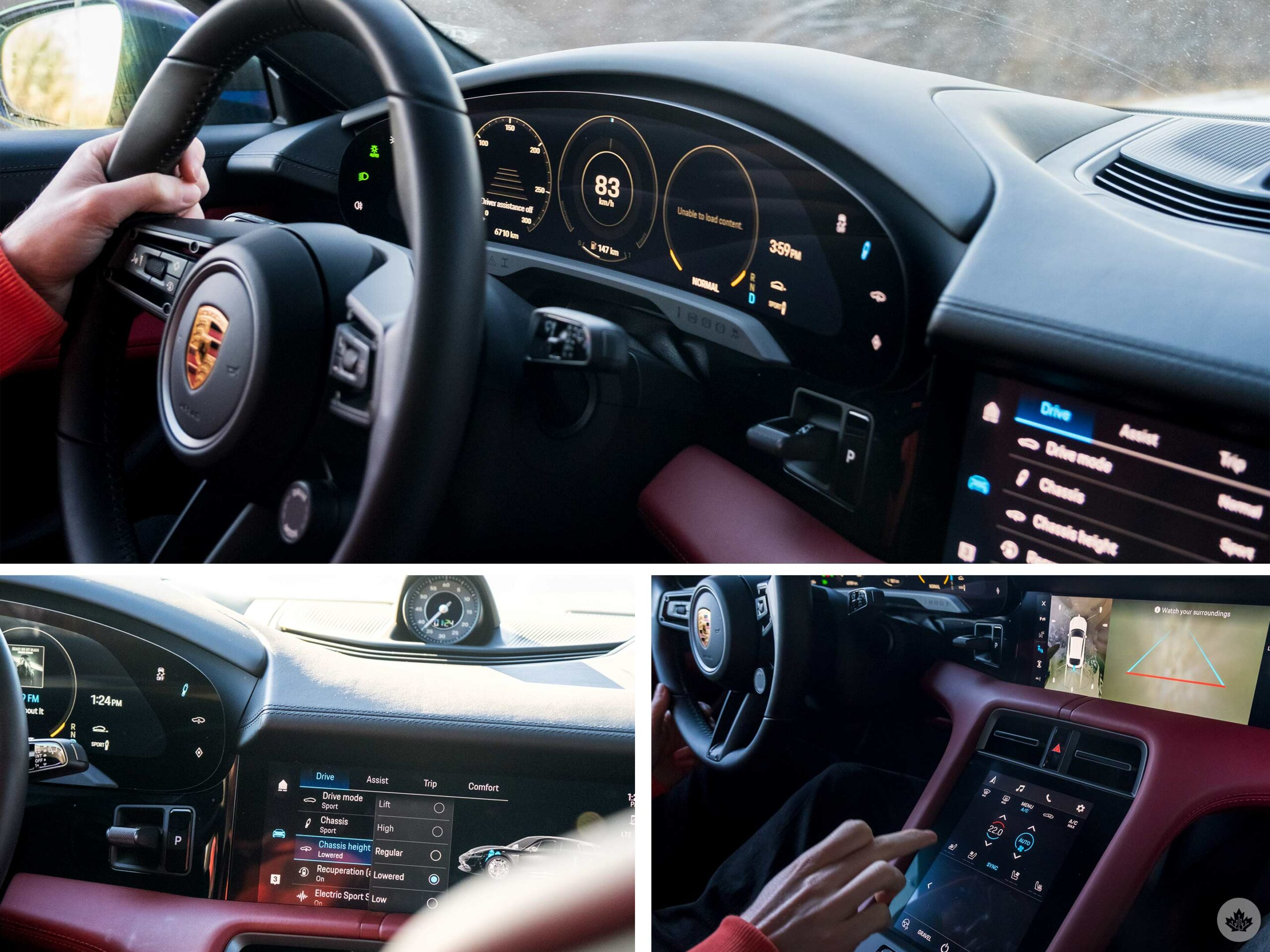
When it comes to infotainment, not much has changed from the regular Taycan. It still feels a lot like a spaceship when sitting in the vehicle’s cockpit thanks to all of the screens and lights.
Since this is my fourth time with a Taycan, amounting to a total of around 13-14 days, I’m a lot more used to the controls and where things are hidden than I was before. Still, there’s a steep learning curve to Porsche’s UI. Further, I miss physical buttons for volume and climate controls. The digital touchpad is also somewhat gimmicky and not a feature I found reliable enough to use often.
Since I didn’t use the touchpad, I found the fount touch screen to be too wide. If it were an inch closer to the driver’s seat – or just a bit less rectangular in general – I wouldn’t need to sit up and lean forward to interact with the far side of it since it stretches out so far away from the driver. CarPlay also doesn’t need a screen this large, resulting in the icons and boxes being stretched out in some apps. It’s not super noticeable, but compared to my much smaller 7-inch Jetta display, there’s a lot of empty space on the Porsche’s screen. I noticed this with the Ioniq 5 as well, so hopefully, Apple and other devs will start making apps that take better advantage of the larger in-car displays now available in higher-end vehicles. I will mention that Porsche now also supports Android Auto.
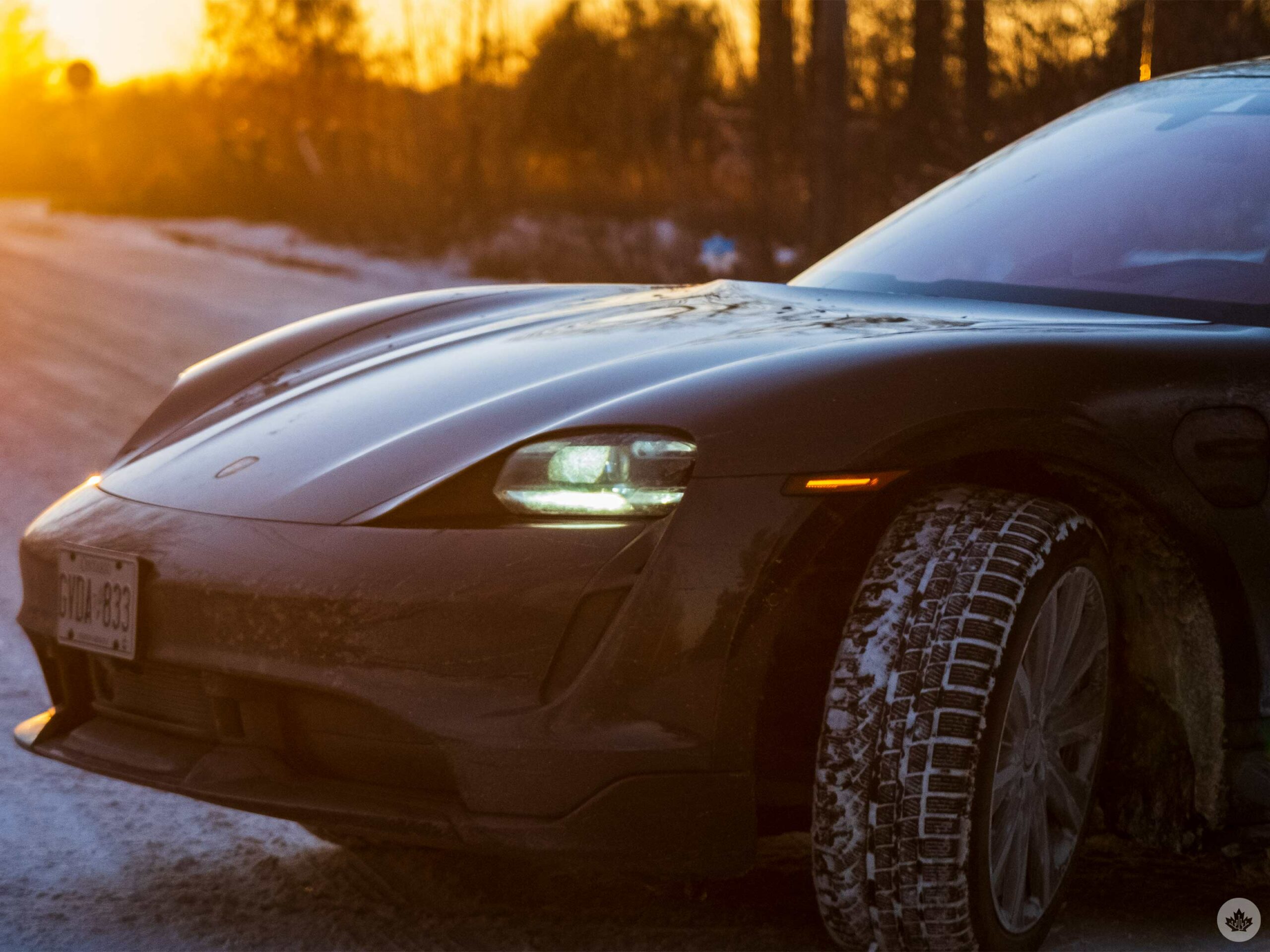
None of this is a major complaint, however. Everything functioned well, except for the rear defrost, which seemed to only stay on for roughly five seconds at a time. As much as I would have wished for that to be fixed, the rear wiper worked well enough and ‘Innodrive’ made driving on the highway super easy.
Innodrive is Porsche’s advanced driver assistance mode that combines adaptive cruise control, lane-keeping assist, nav and street sign data, and more to help make driving as effortless as possible.
On my first day driving with the Cross Turismo, I didn’t want to use Innodrive since driving the EV is so fun. The second and third days had too much snow on the roads for the feature to function properly, but on my drive back to the city along the 401, Innodrive worked like a dream and made my early morning drive easier. It’s a really interesting experience to be gliding along the 401 silently in a car that’s doing most of the driving work for you. Of course, you still need to keep your hands on the wheel and help ease through some corners, but in terms of speed and keeping within the road’s lines, the Cross Turismo did an outstanding job when the weather conditions were ideal.
One good charger can make a lot of difference
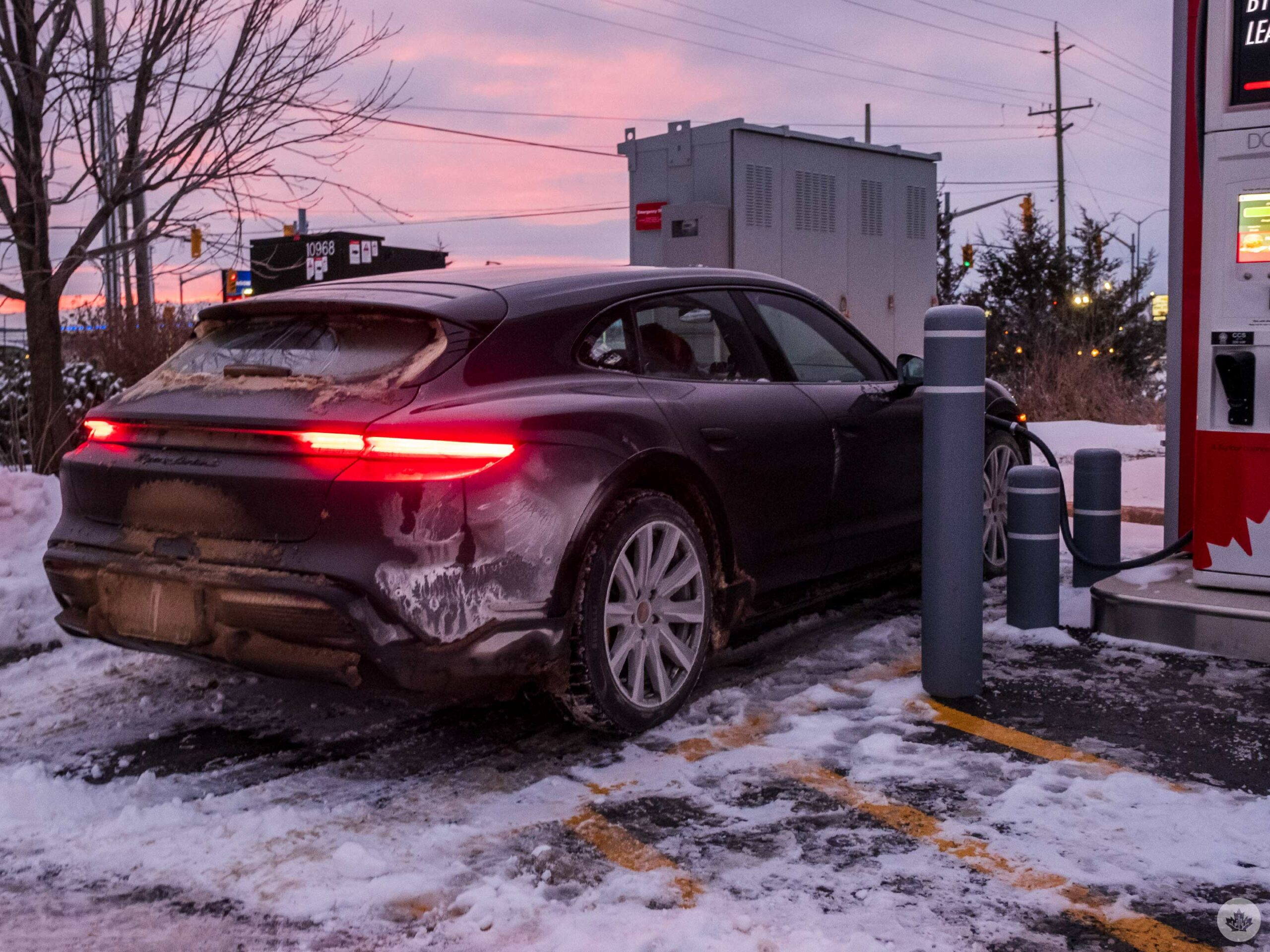
Charging is always one of the most complex and important aspects of testing out an electric vehicle. Since I just test EVs and don’t own one, I don’t have a perfect solution for charging at home. I rely on nearby fast chargers when I’m in Toronto to top me up. There’s also a level-2 charger two streets over that I can leave EVs at overnight and walk home from. It’s not very convenient, but I never worry about getting stranded.
Since I assume most EV owners will install chargers at their homes, they would live a much different charging life and start every morning with a topped-off vehicle. This is probably the ideal scenario for most electric vehicle owners, so try to factor the price of a 240-volt outlet installation in your garage or outside near a parking space into the cost of buying an EV.
This time, I decided to take the car on a bit of trip to visit my parents to see what driving 4-5 hours in an EV to a rural Canadian town would be like. The experience overall wasn’t bad and I made it back in one piece, but I underestimated the amount of planning I needed to do to make sure the car had charging locations at all of my planned stops.

Instead of going straight from Toronto to Renfrew, ON, I needed to stop along the 401 at Coburg on the way to Renfrew and then in Napanee on the way back. Both towns had Petro Canada DC 350 kW fast chargers, so we only needed to stop for around 40 minutes to get from 61 percent to full in Coburg and 1 hour and 10 minutes to get from 36 percent to 89 percent in Napanee (it was much colder during the second stop).
In Renfrew, I was unable to use the 240-volt charger Porcshe provided because I was planning to plug it into my parents’ dryer outlet, but it used a NEMA 14-30 plug interface and the Porshe utilizes a NEMA 14-50, the same plug that a stove runs on. If we got into a bind, we could have parked the Porsche in the backyard on the grass and ran the cable out the kitchen window since it’s about 7.5m (roughly 25-feet) long, but we found two local chargers in town.
One was at a grocery store very close to home, but it took 24-hours to power up the Cross Turismo, so it was a last resort option. The other charger is a moderately newer Flo DC-level-3 fast charger that Flo rates to provide approximately 250km of range an hour with a 50kW charge. In my experience, that was pretty accurate since it would top up the Cross Turismo to 100 percent in just shy of two hours.
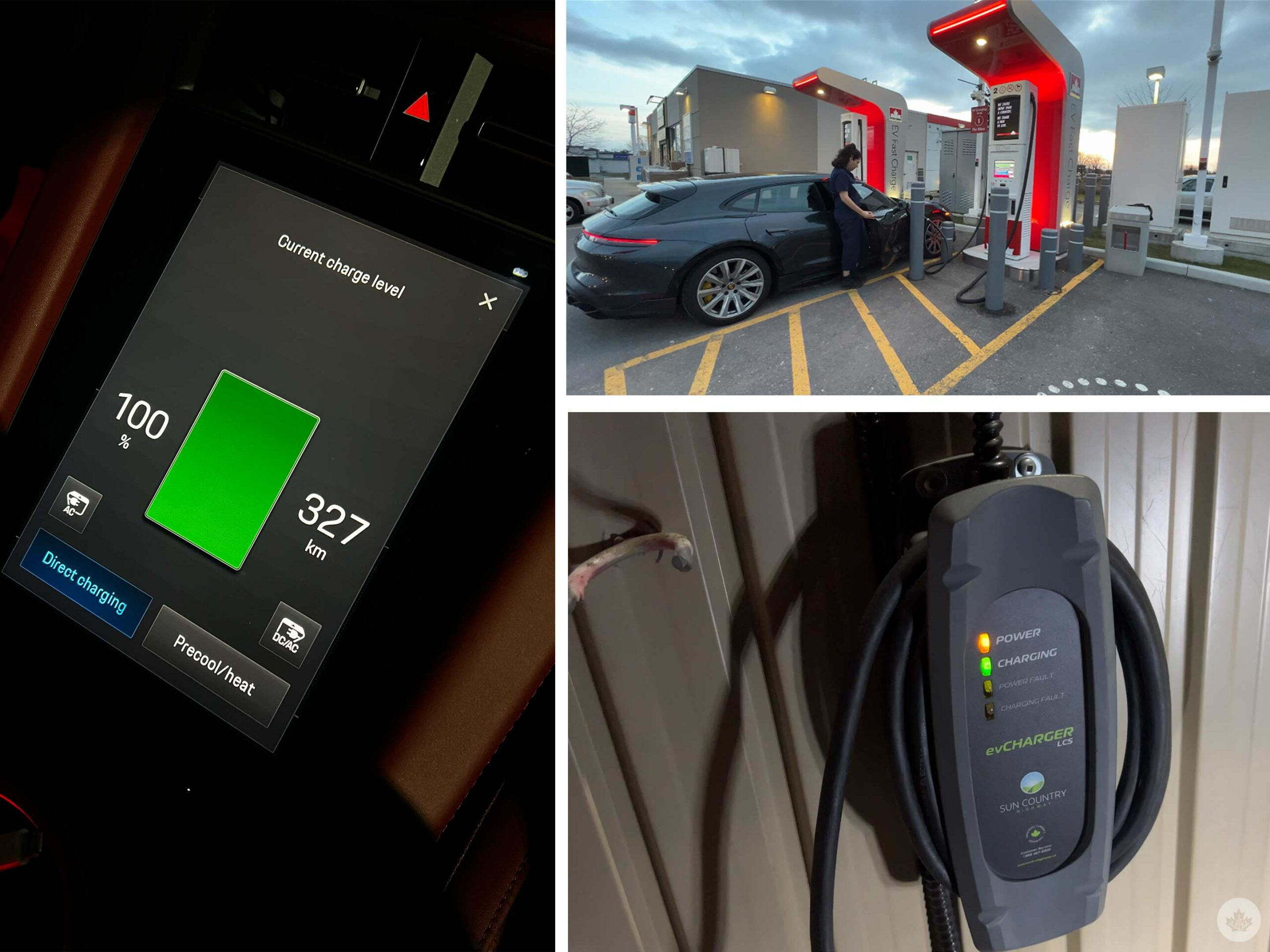
However, the car only started with 307km of range after that charge, instead of the 417km that we had when we picked it up from Porsche. There was a roughly 10-15-degree temperature gap between the days, but the range drop was surprising nonetheless.
That said, once I found the faster charger from Flo, I was golden. Two hours is about an hour longer than I’m willing to wait in the car, especially in the winter, but since I was visiting family, I was able to coordinate drives and people to pick me up and drop me back off once the car was in the high 90s of charge.
This obviously isn’t the best scenario, but when the first 120-volt home charger wouldn’t fit in the dryer socket, I had flashbacks to my first Taycan experience where the charger door accidentally got forced open when it was covered with ice, resulting in a disabled fast-charging port. In that case, the EV was loaded onto a flatbed tow truck and sent back to Porsche to be repaired. This time, though, we were able to push through with a lot of help from my family.
If I was visiting a strange town, it would have either resulted in me sitting in the car watching a lot of YouTube, using the car’s data plan, or calling cabs/Ubers to take me where I needed to be and back.
The end of the road
After driving almost 1,000km, charging this car all over the eastern side of Ontario and getting to experience it on some clear, winding roads, I’ve fallen for the Cross Turismo version of the Taycan just as hard as I did the standard Taycan last year.
There are some angles in photos where the Cross Turismo doesn’t look incredibly sporty, but in person, its scale feels nice and looks incredible from pretty much every angle. Plus, once you’re inside, it feels as amazing as the Taycan, so it’s a top-class ride through and through. If you didn’t have to look back, you’d never know that you’re hauling around a four-door hatchback based on the way this thing moves.
Plus, the added reassurance of being able to handle gravel roads, some potholes, and speedbumps without needing to worry about the low ride was also really nice if you plan to use this as an everyday vehicle.
The only real holdup to buying one was how inconsistent the range was and the estimated kilometres. Hopefully, we keep seeing more and more 350kW chargers popping up around to make travelling long distances a little less stressful, but that’s not available in Porsche’s EV. That’s on other companies and governments to figure out.
The Taycan Cross Turismo I drove starts at $218,000, but the base model starts at $119,000 and I think you’d have a very similar experience in that model as well.
"After driving almost 1,000km, charging this car all over the eastern side of Ontario and getting to experience it on some clear winding roads, I’ve fallen for the Cross Turismo version of the Taycan just as hard as I did the standard Taycan last year."
MobileSyrup may earn a commission from purchases made via our links, which helps fund the journalism we provide free on our website. These links do not influence our editorial content. Support us here.

